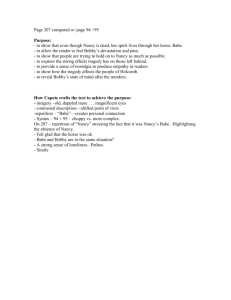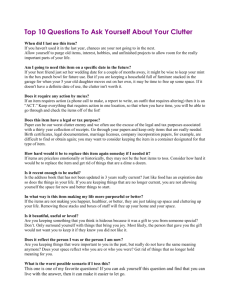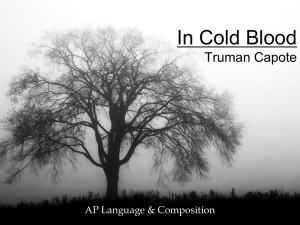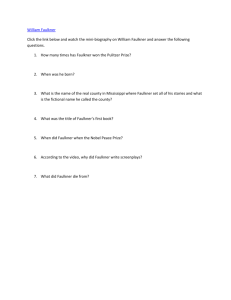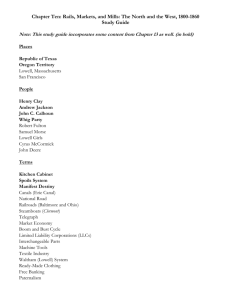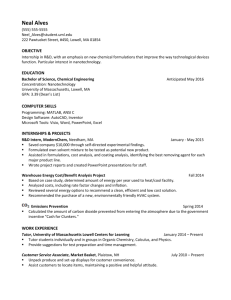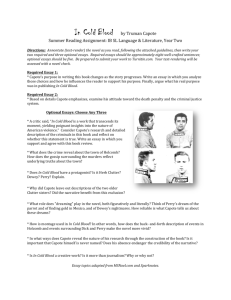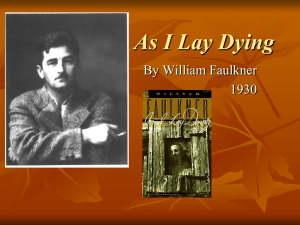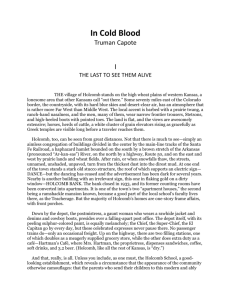Lecture quotes
advertisement
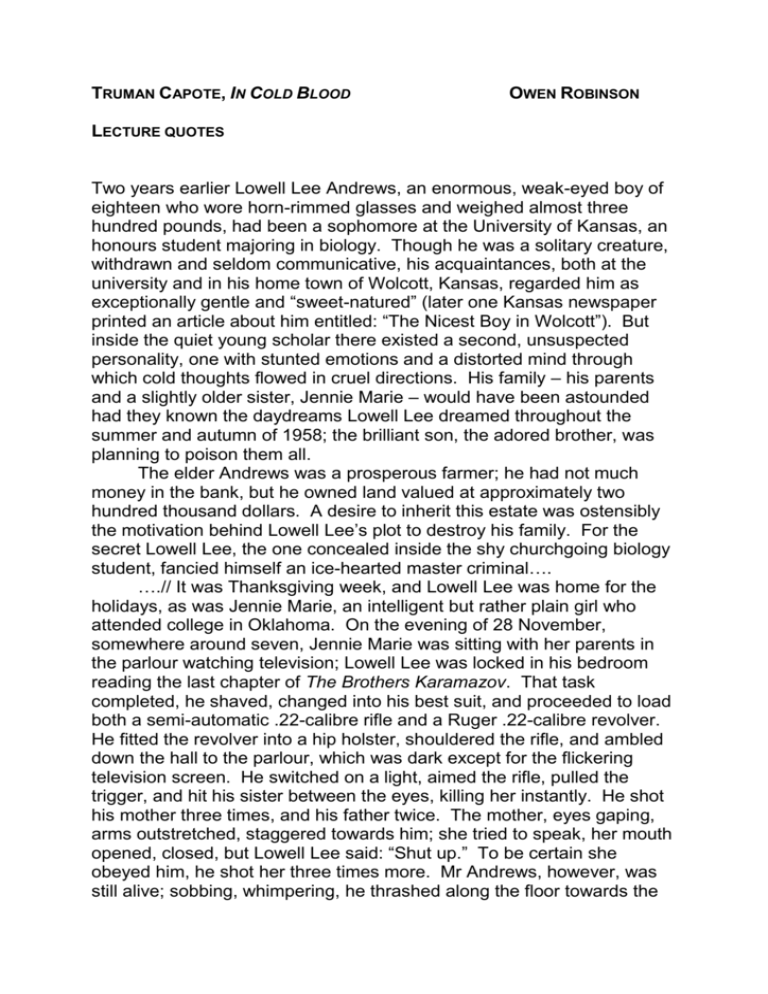
TRUMAN CAPOTE, IN COLD BLOOD OWEN ROBINSON LECTURE QUOTES Two years earlier Lowell Lee Andrews, an enormous, weak-eyed boy of eighteen who wore horn-rimmed glasses and weighed almost three hundred pounds, had been a sophomore at the University of Kansas, an honours student majoring in biology. Though he was a solitary creature, withdrawn and seldom communicative, his acquaintances, both at the university and in his home town of Wolcott, Kansas, regarded him as exceptionally gentle and “sweet-natured” (later one Kansas newspaper printed an article about him entitled: “The Nicest Boy in Wolcott”). But inside the quiet young scholar there existed a second, unsuspected personality, one with stunted emotions and a distorted mind through which cold thoughts flowed in cruel directions. His family – his parents and a slightly older sister, Jennie Marie – would have been astounded had they known the daydreams Lowell Lee dreamed throughout the summer and autumn of 1958; the brilliant son, the adored brother, was planning to poison them all. The elder Andrews was a prosperous farmer; he had not much money in the bank, but he owned land valued at approximately two hundred thousand dollars. A desire to inherit this estate was ostensibly the motivation behind Lowell Lee’s plot to destroy his family. For the secret Lowell Lee, the one concealed inside the shy churchgoing biology student, fancied himself an ice-hearted master criminal…. ….// It was Thanksgiving week, and Lowell Lee was home for the holidays, as was Jennie Marie, an intelligent but rather plain girl who attended college in Oklahoma. On the evening of 28 November, somewhere around seven, Jennie Marie was sitting with her parents in the parlour watching television; Lowell Lee was locked in his bedroom reading the last chapter of The Brothers Karamazov. That task completed, he shaved, changed into his best suit, and proceeded to load both a semi-automatic .22-calibre rifle and a Ruger .22-calibre revolver. He fitted the revolver into a hip holster, shouldered the rifle, and ambled down the hall to the parlour, which was dark except for the flickering television screen. He switched on a light, aimed the rifle, pulled the trigger, and hit his sister between the eyes, killing her instantly. He shot his mother three times, and his father twice. The mother, eyes gaping, arms outstretched, staggered towards him; she tried to speak, her mouth opened, closed, but Lowell Lee said: “Shut up.” To be certain she obeyed him, he shot her three times more. Mr Andrews, however, was still alive; sobbing, whimpering, he thrashed along the floor towards the kitchen, but at the kitchen’s threshold the son unholstered his revolver and discharged every chamber, then reloaded the weapon and emptied it again; altogether, his father absorbed seventeen bullets. Andrews, according to statements credited to him, “didn’t feel anything about it. The time came, and I was doing what I had to do. That’s all there was to it”….(Truman Capote, In Cold Blood (London: Penguin, 1966), pp.304-5). Perry gripped the edge of the washbasin and hauled himself to a standing position. His legs trembled; the pain in his knees made him perspire. He wiped his face with a paper towel. He unlocked the door and said, “OK. Let’s go.” Nancy’s bedroom was the smallest, most personal room in the house – girlish, and as frothy as a ballerina’s tutu. Walls, ceiling, and everything else except a bureau and a writing-desk, were pink or blue or white. The white-and-pink bed, piled with blue pillows, was dominated by a big pinkand-white Teddy bear – a shooting-gallery prize that Bobby had won at the county fair. A cork bulletin board, painted pink, hung above a whiteskirted dressing-table, dry gardenias, the remains of some ancient corsage, were attached to it, and old valentines, newspaper recipes, and snapshots of her baby nephew and of Susan Kidwell and of Bobby Rupp, Bobby caught in a dozen actions – swinging a bat, dribbling a basketball, driving a tractor, wading, in bathing trunks, at the edge of McKinney Lake (which was as far as he dared go, for he had never learned to swim). And there were photographs of the two together – Nancy and Bobby. Of these, she liked best one that showed them sitting in a leaf-dappled light amid picnic debris and looking at one another with expressions that, though unsmiling, seemed mirthful and full of delight. Other pictures, of horses, of cats deceased but unforgotten – like “poor Boobs”, who had died not long ago and most mysteriously (she suspected poison) – encumbered her desk. Nancy was invariably the last of the family to retire; as she had once informed her friend and home-economics teacher, Mrs Polly Stringer, the midnight hours were her “time to be selfish and vain”. It was then that she went through her beauty routine, a cleansing, creaming ritual, which on Saturday nights included washing her hair. Tonight, having dried and brushed her hair and bound it in a gauzy bandanna, she set out the clothes she intended to wear to church the next morning: nylons, black pumps, a red velveteen dress – her prettiest, which she herself had made. It was the dress in which she was to be buried. Before saying her prayers, she always recorded in a diary a few occurrences (“Summer here. Forever, I hope. Sue over and we rode Babe down to the river. Sue played her flute. Fireflies”) and an occasional outburst “I love him, I do”). It was a five-year diary; in the four years of its existence she had never failed to make an entry, though the splendour of several events (Eveanna’s wedding, the birth of her nephew) and the drama of others (her “first REAL quarrel with Bobby” – a page literally tear-stained) had caused her to usurp space allotted to the future. A different-tinted ink identified each year: 1956 was green and 1957 a ribbon of red, replaced the following year by bright lavender, and now, in 1959, she had decided upon a dignified blue. But as in every manifestation, she continued to tinker with her handwriting, slanting it to the right or to the left, shaping it roundly or steeply, loosely or stingily – as though she were asking, “Is this Nancy? Or that? Or that? Which is me?” (Once Mrs Riggs, her English teacher, had returned a theme with a scribbled comment: “Good. But why written in three styles of script?” To which Nancy had replied: “Because I’m not grown-up enough to be one person with one kind of signature.”) Still, she had progressed in recent months, and it was in a handwriting of emerging maturity that she wrote, “Jolene K. came over and I showed her how to make a cherry-pie. Practised with Roxie. Bobby here and we watched TV. Left at eleven.” “This is it, this is it, this has to be it, there’s the school, there’s the garage, now we turn south.” To Perry, it seemed as though Dick were muttering jubilant mumbo-jumbo. They left the highway, sped through a deserted Holcomb, and crossed the Santa Fe tracks. “The bank, that must be the bank, now we turn west – see the trees? This is it, this has to be it.” The headlights disclosed a line of Chinese elms; bundles of wind-blown thistle scurried across it. Dick doused the headlights, slowed down, and stopped until his eyes adjusted to the moon-illuminated light. Presently, the car crept forward. (pp.54-6) <> FOR IMMEDIATE RELEASE Contact: Faulkner Real Estate Sue Wieland 1015 N. Arapahoe Ulysses, KS 67880 (620) 353-4741 The Clutter House, featured in Capote’s In Cold Blood, is up for Sale Holcomb, KS – August 29, 2006 – The Clutter House, a national historic home and the basis of the book, In Cold Blood, written by Truman Capote, is currently being offered for sale by Faulkner Real Estate. The Clutter House was the scene of a grisly murder in 1959 in Holcomb, Kansas. The house’s original owner, Herbert Clutter, was found dead, along with his wife and two teenaged children early one fall morning. The house has since gained even more national attention by being the focus of Truman Capote’s book, In Cold Blood. The story of the Clutter House has also been memorialized on screen with two movies, the first actually being shot in and around the Clutter House. The house is currently owned by Donna and Leonard Mader. The Maders’ took ownership of the house in 1990, and are the third owners of the historic Clutter House. One of the Maders’ neighbors, Sonnie Baird, states, “It’s like the Amityville Horror House in New York, or J.R. Ewing’s house outside Dallas.” Faulkner Real Estate in Ulysses, KS is currently handling the sale of the Clutter House. The sale is offered as a “Private Auction,” a sales method developed by Mark Faulkner. Faulkner Real Estate has been in business for over 20 years, and offers residential, commercial, and agricultural real estate. For more information on Faulkner Real Estate, please visit: http://www.faulknerrealestate.com. You may view the house online at EBay or Faulkner’s web site


